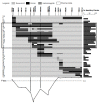Identification of a Rice stripe necrosis virus resistance locus and yield component QTLs using Oryza sativa x O. glaberrima introgression lines
- PMID: 20064202
- PMCID: PMC2824796
- DOI: 10.1186/1471-2229-10-6
Identification of a Rice stripe necrosis virus resistance locus and yield component QTLs using Oryza sativa x O. glaberrima introgression lines
Abstract
Background: Developing new population types based on interspecific introgressions has been suggested by several authors to facilitate the discovery of novel allelic sources for traits of agronomic importance. Chromosome segment substitution lines from interspecific crosses represent a powerful and useful genetic resource for QTL detection and breeding programs.
Results: We built a set of 64 chromosome segment substitution lines carrying contiguous chromosomal segments of African rice Oryza glaberrima MG12 (acc. IRGC103544) in the genetic background of Oryza sativa ssp. tropical japonica (cv. Caiapó). Well-distributed simple-sequence repeats markers were used to characterize the introgression events. Average size of the substituted chromosomal segments in the substitution lines was about 10 cM and covered the whole donor genome, except for small regions on chromosome 2 and 4. Proportions of recurrent and donor genome in the substitution lines were 87.59% and 7.64%, respectively. The remaining 4.78% corresponded to heterozygotes and missing data. Strong segregation distortion was found on chromosomes 3 and 6, indicating the presence of interspecific sterility genes. To illustrate the advantages and the power of quantitative trait loci (QTL) detection using substitution lines, a QTL detection was performed for scored traits. Transgressive segregation was observed for several traits measured in the population. Fourteen QTLs for plant height, tiller number per plant, panicle length, sterility percentage, 1000-grain weight and grain yield were located on chromosomes 1, 3, 4, 6 and 9. Furthermore, a highly significant QTL controlling resistance to the Rice stripe necrosis virus was located between SSR markers RM202-RM26406 (44.5-44.8 cM) on chromosome 11.
Conclusions: Development and phenotyping of CSSL libraries with entire genome coverage represents a useful strategy for QTL discovery. Mapping of the RSNV locus represents the first identification of a genetic factor underlying resistance to this virus. This population is a powerful breeding tool. It also helps in overcoming hybrid sterility barriers between species of rice.
Figures






Similar articles
-
Genomic introgressions from African rice (Oryza glaberrima) in Asian rice (O. sativa) lead to the identification of key QTLs for panicle architecture.BMC Genomics. 2023 Oct 4;24(1):587. doi: 10.1186/s12864-023-09695-6. BMC Genomics. 2023. PMID: 37794325 Free PMC article.
-
Construction of chromosome segment substitution lines of Dongxiang common wild rice (Oryza rufipogon Griff.) in the background of the japonica rice cultivar Nipponbare (Oryza sativa L.).Plant Physiol Biochem. 2019 Nov;144:274-282. doi: 10.1016/j.plaphy.2019.09.041. Epub 2019 Sep 25. Plant Physiol Biochem. 2019. PMID: 31593900
-
Construction of introgression lines carrying wild rice (Oryza rufipogon Griff.) segments in cultivated rice (Oryza sativa L.) background and characterization of introgressed segments associated with yield-related traits.Theor Appl Genet. 2006 Feb;112(3):570-80. doi: 10.1007/s00122-005-0165-2. Epub 2005 Dec 6. Theor Appl Genet. 2006. PMID: 16331476
-
2Gs and plant architecture: breaking grain yield ceiling through breeding approaches for next wave of revolution in rice (Oryza sativa L.).Crit Rev Biotechnol. 2024 Feb;44(1):139-162. doi: 10.1080/07388551.2022.2112648. Epub 2022 Sep 29. Crit Rev Biotechnol. 2024. PMID: 36176065 Review.
-
A Rice Genetic Improvement Boom by Next Generation Sequencing.Curr Issues Mol Biol. 2018;27:109-126. doi: 10.21775/cimb.027.109. Epub 2017 Sep 8. Curr Issues Mol Biol. 2018. PMID: 28885178 Review.
Cited by
-
Development and use of chromosome segment substitution lines as a genetic resource for crop improvement.Theor Appl Genet. 2019 Jan;132(1):1-25. doi: 10.1007/s00122-018-3219-y. Epub 2018 Nov 27. Theor Appl Genet. 2019. PMID: 30483819 Review.
-
Genetic characterization and fine mapping of qHMS4 responsible for pollen sterility in hybrids between Oryza sativa L. and Oryza glaberrima Steud.Mol Breed. 2022 Aug 12;42(8):47. doi: 10.1007/s11032-022-01306-8. eCollection 2022 Aug. Mol Breed. 2022. PMID: 37313516 Free PMC article.
-
ddRAD-seq derived genome-wide SNPs, high density linkage map and QTLs for fruit quality traits in strawberry (Fragaria x ananassa).3 Biotech. 2020 Aug;10(8):353. doi: 10.1007/s13205-020-02291-5. Epub 2020 Jul 27. 3 Biotech. 2020. PMID: 32760641 Free PMC article.
-
Genetic dissection of fruit quality traits in the octoploid cultivated strawberry highlights the role of homoeo-QTL in their control.Theor Appl Genet. 2012 Apr;124(6):1059-77. doi: 10.1007/s00122-011-1769-3. Epub 2012 Jan 4. Theor Appl Genet. 2012. PMID: 22215248 Free PMC article.
-
Distinct evolutionary patterns of Oryza glaberrima deciphered by genome sequencing and comparative analysis.Plant J. 2011 Jun;66(5):796-805. doi: 10.1111/j.1365-313X.2011.04539.x. Epub 2011 Mar 21. Plant J. 2011. PMID: 21323774 Free PMC article.
References
Publication types
MeSH terms
LinkOut - more resources
Full Text Sources

